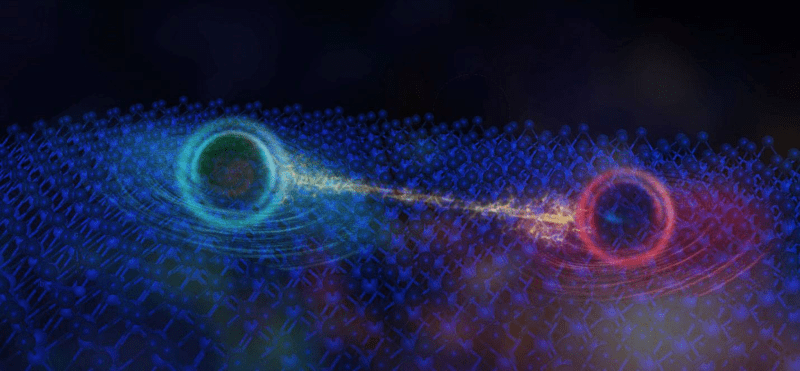If there are two classes of matter that electronics people can agree on, its conductors and insulators. Electrically, conductors and insulators don’t have much in common. The same has held true in the quantum physics world until some research at Princeton has suggested that quantum oscillation — a phenomenon associated with metals — is taking place in an insulator. Scientists aren’t sure what’s really happening yet, but it may suggest there is a new quantum particle yet to be discovered.
In metals, electrons are very mobile which allows a relatively easy flow of electrical current. However, at low temperatures, a magnetic field can shift electrons to a quantum state causing its resistance to change in an oscillating pattern. Insulators generally do not exhibit this effect.
Researchers made a monolayer of tungsten ditelluride using the same kind of adhesive tape process you see to create graphene. In bulk, the material is a conductor but in a monolayer, tungsten ditelluride is an insulator.
The researchers postulate there may be a neutral-charge quantum particle responsible for the effect. We aren’t physics gurus, but we’ll be interested to see if anyone finds this effect in an insulator that didn’t start off being a conductor. We also aren’t sure how this relates to earlier work with quantum oscillations in Kondo insulators which also took place at Princeton.
A new quantum particle could be a big deal for quantum computing. That could scramble the playing field on the race to make a really practical machine.
















I wouldn’t bet my money on a new particle though…
And we should first use up all the old ones…
Fair, but at the same time ‘we’ (humankind) keep thinking that we understand stuff, and then keep coming back to that a few decades later, been happening since forever, and will keep happening until we actually have a working theory of everything.
My 2 cents: stay open minded to the idea that we dont even remotely understand the universe we live in, yet.
The first step to wisdom is knowing just how ignorant you are.
Probably better to know where you are ignorant and why.
Knowing you are ignorant in itself, doesn’t help much.
Yeah, what I know is that I’m gonna ignore that…
(No animals of any kind including ******-supporters where harmed)
how many times in history has this been said?
I’m going to go out on a limb (without having read the original article) and assume what they mean is that they may have found a new type of quasiparticle (https://en.wikipedia.org/wiki/Quasiparticle), like a phonon: https://en.wikipedia.org/wiki/Phonon.
I think so too. Haven’t read it either, though.
Very honest question: Has HaD ever featured a HaD-level HaD-article to Maxwell’s equations? I’d sometimes like to point technical people at something that is sensibly correct, but doesn’t require them to have taken the full amount Physics students or EE students math?
I’m _also_ asking because jumping into field effects that (usually) happen on metal surfaces under conditions so extreme that Maxwell isn’t sufficient to explain reality feels a bit like leaving out the part before “… and now draw the rest of the ferking owl”.
Bonus points for transforming Maxwell’s equatinons into Fourier transform to show how lenses work.
https://hackaday.com/?s=Maxwell
I like the Kondo Effect, as time reversal would form a lag in a particle travel.
I’m experiencing reverse Kondo effect no matter where I live, it always gets messy.
I’ve been working on a hypothesis relating to superimposed concurrent iterations for a while.
It would lend well to this sort of effect. Initially it was a way to predict the outcome of entanglement but it’s evolved somewhat and now incorporates tunneling, gravity, inertia and electromagnetic waves. The oscillation, under my hypothesis, would effectively be what could be considered to an observer as a time paradox with some hysteresis and a phase lag.
Wonder what happens if you interleave these with graphene sheets?
Free power from fluctum quantuations.
Miniature Tesla coils made from carbon-boron nanotubes, with a buckyball topload, on a semiconductor ground plain, embedded in a superconductive medium. If the tungsten ditelluride could be woven into the helix of a nanotube, and the nanotubes could be aligned like a forest, they could simply be sandwiched between two conductors and stacked into a battery of resonant cells. Then you could make a parallel area of those cells and inject a currant pulse across it to bring them into alignment. The resulting lower frequency transverse wave would be your output, effectively the individual strings of batteries would each a slight time delay in their output, resulting in a traveling wave a bit like an earthquake across the battery bank, at a more useable frequency.
+1
A new passenger rather than a driver, has been found.
maybe an new cpu clocked at 1.09E18Hz ?
Related : https://en.wikipedia.org/wiki/Topological_insulator